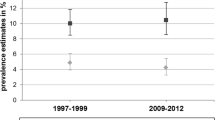Abstract.
Background: Epidemiological studies have reported lifetime prevalence rates for major depression that have typically ranged between 10 % and 20 %, and have typically been fairly stable across age groups. This contradicts the intuitive expectation that lifetime prevalence should accumulate with age. Some authors have hypothesized that a cohort effect may account for this puzzling pattern, but another possible explanation is recall bias. In principle, differential mortality could also account for a failure of age-specific lifetime prevalence to increase with age. The objective of this study was to describe the relationship between recall failure (failure to recall previous depressive episodes) and bias in the evaluation of age-specific lifetime major depression prevalence. Method: A framework recently described by Hill et al. was used in this analysis. Hill's model relates the slope of an age-specific prevalence curve for an irreversible disease to incidence and mortality. The model is applicable in the current context since lifetime major depression is, by definition, an irreversible condition (albeit one typically characterized by recurring episodes). In the current investigation, an extra term for recall failure was added to the model. In order to incorporate mortality, a structured literature review was conducted and the impact of plausible levels of differential mortality was explored. Results: Relatively low rates of recall failure (e. g. 2–4 % per year) can account for a flat or declining age-specific lifetime prevalence curve in most age groups, with higher rates of recall failure being necessary in the adolescent age range. Among the elderly, where mortality rates are higher, differential mortality may also contribute to the pattern. Conclusions: Available data about the incidence of major depression, and the mortality associated with this condition, suggest that plausible rates of recall failure can explain a flat or declining lifetime major depression prevalence across age groups. A corollary of this result is that many existing estimates of major depression lifetime prevalence may be too low. A cohort effect can be inferred from cross-sectional lifetime prevalence data only when the diagnostic instruments employed make recall failure very unlikely.
Similar content being viewed by others
Author information
Authors and Affiliations
Additional information
Accepted: 4 February 2003
Correspondence to Dr. Scott Patten
Rights and permissions
About this article
Cite this article
Patten, S. Recall bias and major depression lifetime prevalence. Soc Psychiatry Psychiatr Epidemiol 38, 290–296 (2003). https://doi.org/10.1007/s00127-003-0649-9
Issue Date:
DOI: https://doi.org/10.1007/s00127-003-0649-9




